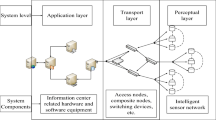Abstract
The dynamic topology of complex networks, the randomness of environmental noise and the uncertainty of data links make it difficult to guarantee the quality of multimedia services. This paper combines synchronization control, robustness perception and fog computing in complex networks to improve the quality of multimedia services, and designs a series of architecture and control algorithms for complex networks. Firstly, a synchronization control algorithm for complex networks is proposed based on the analysis of the multi-edge data flow cannot be exhausted, the mixing of multi-direction information transmission delay, the undirected multi-period characteristics of information collection delay and the requirements of multi-media tasks with different attributes. Then, aiming at optimizing the extraction of multimedia desired quality in complex environment, a multimedia transmission control algorithm is designed based on the robustness of complex network. This algorithm can accurately extract the desired multimedia signal from the environment noise, video, image and other redundant multimedia signals. Secondly, by adjusting the minimum spanning tree size of multipath system and scheduling multimedia data transmission, an intelligent algorithm for multimedia fog computation is designed. Finally, mathematical analysis and simulation experiments verify the correctness of the proposed algorithm from the aspects of real-time, feasibility, execution efficiency and resource utilization.







Similar content being viewed by others
References
Guan W, Wen X, Wang L, Lu Z, Shen Y (2018) A service-oriented deployment policy of end-to-end network slicing based on complex network theory. IEEE Access 6:19691–11970
Geng C, Shiyou QU, Xiao Y et al (2018) Diffusion mechanism simulation of cloud manufacturing complex network based on cooperative game theory. J Syst Eng Electron 29(2):321–335
Bof N, Baggio G, Zampieri S (2017) On the role of network centrality in the controllability of complex networks. IEEE T Contr Syst T 4(3):643–653
Dong H, Hou N, Wang Z et al (2018) Variance-constrained state estimation for complex networks with randomly varying topologies. IEEE T Neur Net Lear 29(7):2757–2768
Yang Y., Li J., Shen D. et.al. Evolutionary dynamics analysis of complex network with fusion nodes and overlap edges. J Syst Eng Electron 2018, 29(3): 549–559
Wang F, Yang Y, Xu X (2017) Synchronization of complex dynamical networks via sampled-data control: a threshold function event-triggered method. In: 2017 29th Chinese Control And Decision Conference (CCDC), pp 7155–7160
Wang W, Wan Y (2017) State estimation for complex network with one step induced delay based on pinning control. In: 2017 29th Chinese Control and Decision Conference (CCDC), pp 1473–1478
Hong H, Chuang J, Hsu C (2016) Animation rendering on multimedia fog computing platforms. In: 2016 IEEE International Conference on Cloud Computing Technology and Science (CloudCom), pp 336–343
Rahman MA, Hossain MS, Hassanain E et al (2018) Semantic multimedia fog computing and IoT environment: sustainability perspective. IEEE Commun Mag 56(5):80–87
Lloret J (2018) Intelligent systems for multimedia delivery in software defined networks. In: 2018 Third International Conference on Fog and Mobile Edge Computing (FMEC), pp 5–6
Shi C, Yan Z, Wang YI et al (2010) A genetic algorithm for detecting communities in large-scale complex networks. Adv Complex Syst 13(01):3–17
Jin Y, Kim HJ, Lee JY, Lee SY, Shim WJ, Hong SH, Lee SS (2010) Hard/soft heterometallic network complex of a macrocycle with endo/exocyclic coordination. Inorg Chem 49(22):10241–10243
Deng X, Bai W, Wu B et al (2012) Modularity modeling and evaluation in community detecting of complex network based on information entropy. Journal of Computer Research & Development 49(4):725–734
Gao Z, Li S, Shang Q et al (2015) Complex networks approach for analyzing the correlation of traditional chinese medicine syndrome evolvement and cardiovascular events in patients with stable coronary heart disease. Evid Based Complement Alternat Med 2015:824850
Zhang X, Ge C, Yong H et al (2016) Modeling and analysis of bus weighted complex network in Qingdao city based on dynamic travel time. Multimed Tools Appl 75(24):17553–17572
Chen RY (2017) An intelligent value stream-based approach to collaboration of food traceability cyber physical system by fog computing. Food Control 71:124–136
Sareen S, Gupta SK, Sood SK (2017) An intelligent and secure system for predicting and preventing Zika virus outbreak using fog computing. Enterp Inf Syst-UK 11(9):1–21
Zeng D, Lin G, Song G et al (2016) Joint optimization of task scheduling and image placement in fog computing supported software-defined embedded system. IEEE Trans Comput 65(12):3702–3712
Wu D, Liu S, Li Z et al (2017) A fog computing-based framework for process monitoring and prognosis in cyber-manufacturing. J Manuf Syst 43:25–34
Jin Y, Li R (2016) Opportunistic cooperative QoS guarantee protocol based on GOP-length and video frame-diversity for wireless multimedia sensor networks. J Inf Hiding and Multimedia Signal Proces 7(2):254–265
Author information
Authors and Affiliations
Corresponding author
Additional information
Publisher’s note
Springer Nature remains neutral with regard to jurisdictional claims in published maps and institutional affiliations.
This article is part of the Topical Collection: Special Issue on Fog/Edge Networking for Multimedia Applications
Guest Editors: Yong Jin, Hang Shen, Daniele D'Agostino, Nadjib Achir, and James Nightingale
Rights and permissions
About this article
Cite this article
Liu, L. Multimedia intelligent fog computing scheme based on robust perception for complex networks. Peer-to-Peer Netw. Appl. 12, 1499–1510 (2019). https://doi.org/10.1007/s12083-019-00729-z
Received:
Accepted:
Published:
Issue Date:
DOI: https://doi.org/10.1007/s12083-019-00729-z




